LG G2 and MSM8974 Snapdragon 800 - Mini Review
by Brian Klug on September 7, 2013 1:11 AM EST- Posted in
- Smartphones
- LG
- Mobile
- LG G2
- Android 4.2
- MSM8974
- Snapdragon 800
GPU Performance
Snapdragon 800 features Qualcomm's Adreno 330 GPU. Qualcomm hasn't stated publicly how Adreno 330 compares to Adreno 320 featured in Snapdragon 600, but it's almost certainly a larger GPU. The 8974 implementation in LG's G2 clocks the Adreno 330 GPU at a maximum of 450MHz, yet we see better performance than the 450MHz Adreno 320 in Snapdragon 600 - lending credibility to the idea of having more execution resources. There's also an 8974AB variant which includes a 100 MHz bump in GPU clocks up to 550 MHz.
3DMark
3DMark for Android features the Ice Storm benchmark and uses OpenGL ES 2.0. Ice Storm is divided into two graphics tests and a physics test. The first graphics test is geometry heavy while the second test is more pixel shader intensive. The physics test, as you might guess, is CPU bound and multithreaded. The overall score takes into account both graphics and physics tests. The benchmark is rendered to an offscreen buffer at 720p/1080p and then scaled up to the native resolution of the device being tested. This is a very similar approach we've seen by game developers to avoid rendering at native resolution on some of the ultra high resolution tablets. The beauty of 3DMark's approach here is the fact that all results are comparable, regardless of a device's native resolution. The downside is we don't get a good idea of how some of the ultra high resolution tablets would behave with these workloads running at their native (> 1080p) resolutions.
For these benchmarks we stuck with the default presets (720p, normal quality).
3DMark performance generally fell very close to Qualcomm's MSM8974 MDP/T, with one exception. The CPU bound physics tests had the G2 far lower down the list than I would've expected. Given that test is mostly a multithreaded CPU benchmark, it's entirely possible that the G2's thermal/frequency governors are set more conservatively there. The performance gains elsewhere over Snapdragon 600/Adreno 320 are huge, but 3DMark can be very influenced by CPU performance so it's not clear how much of this advantage is due to Adreno 330 or Krait 400.
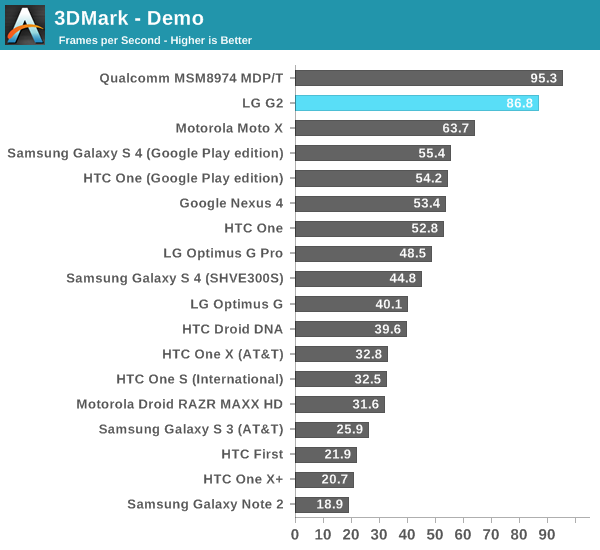
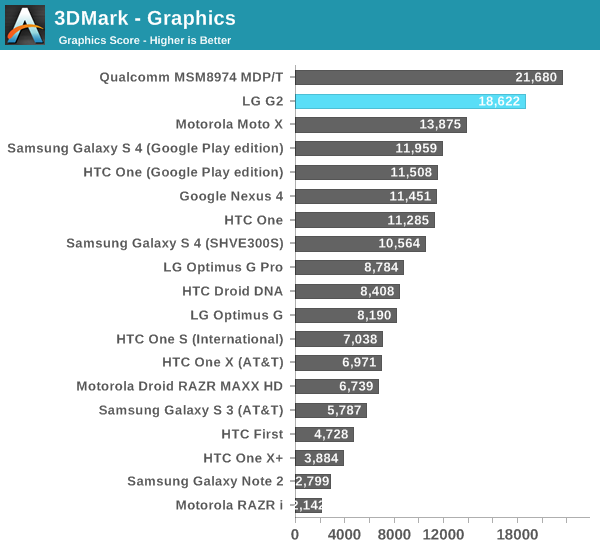
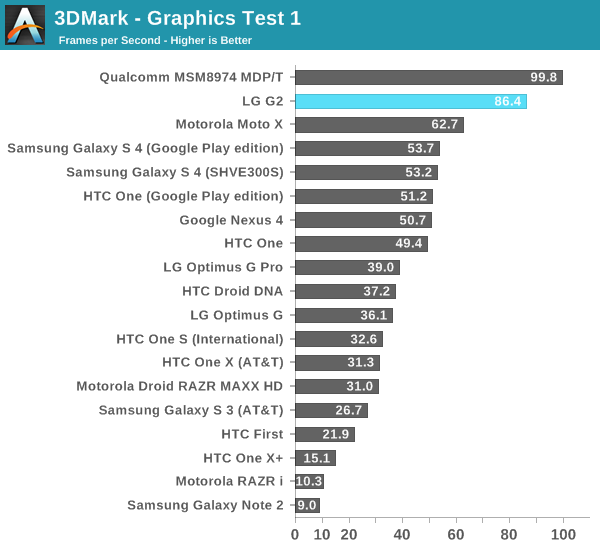
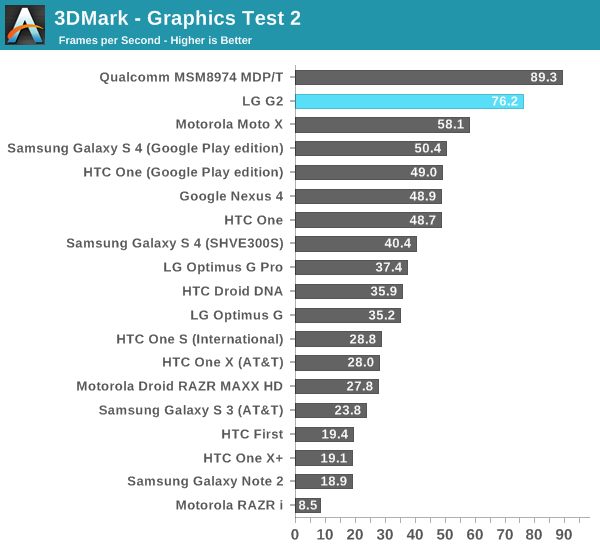
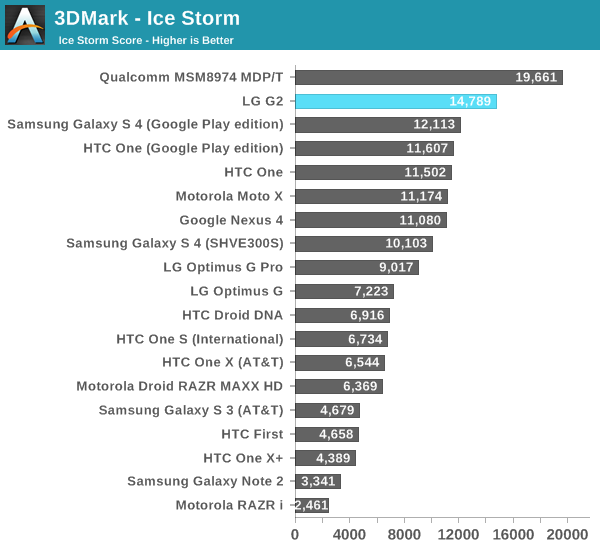
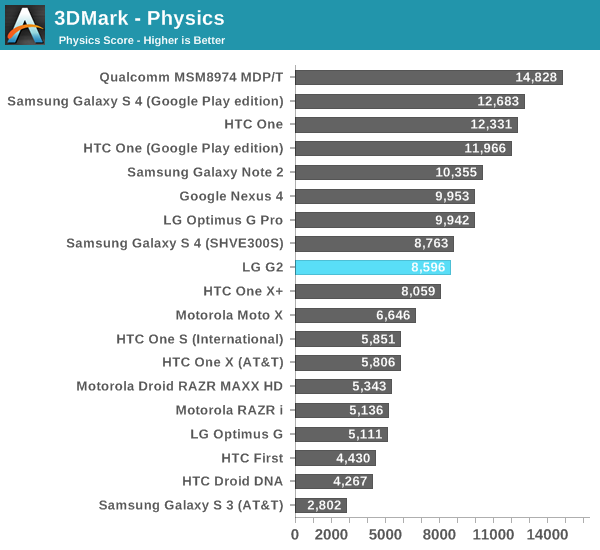
GFXBench 2.7
GFXBench (formerly GLBenchmark) gives us some low level insight into these platforms. As usual, we'll start with the low level tests and move onto the game simulation benchmarks:
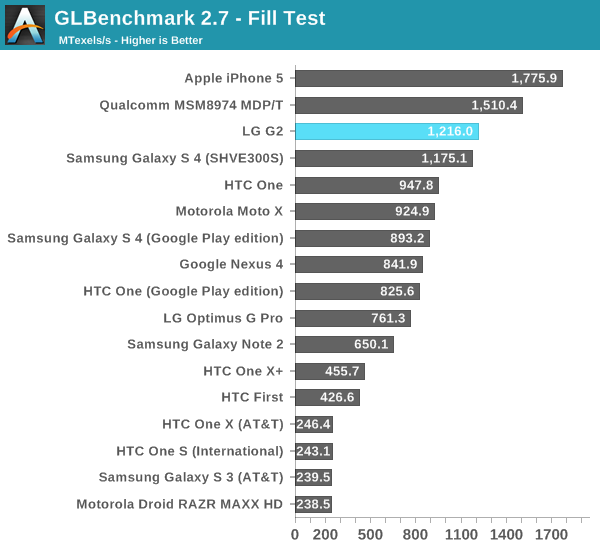
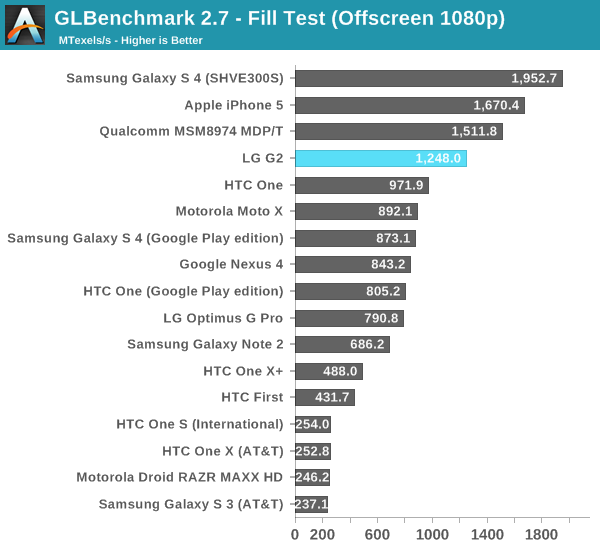
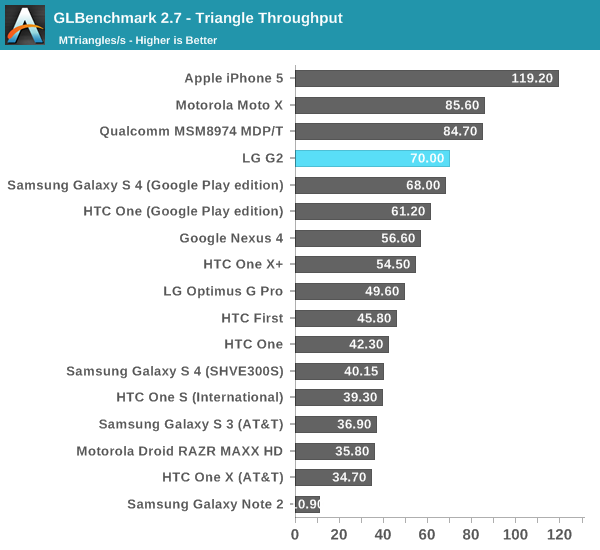
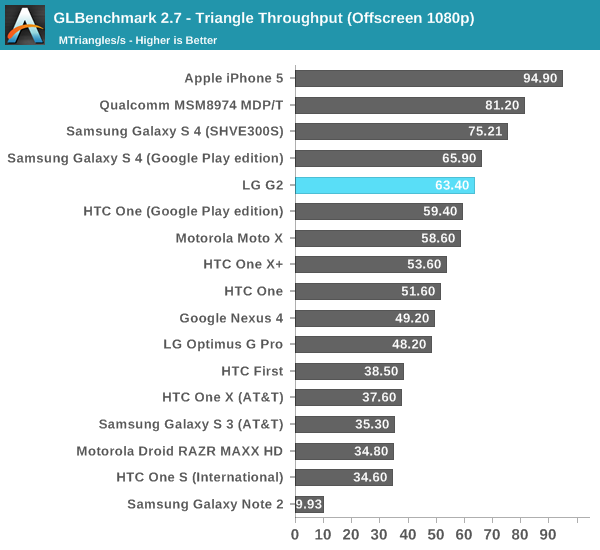
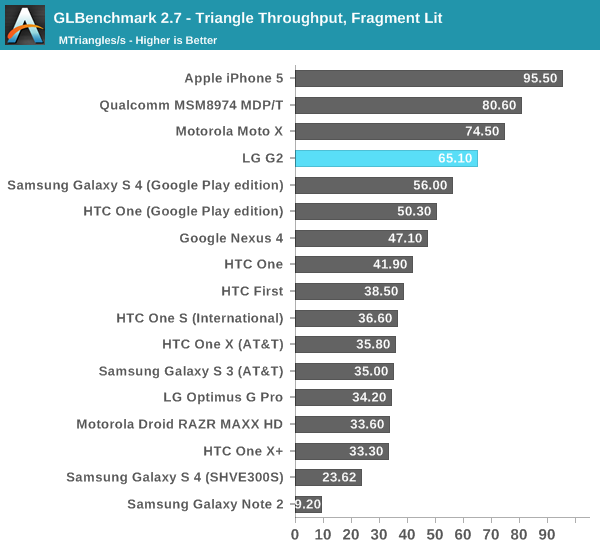
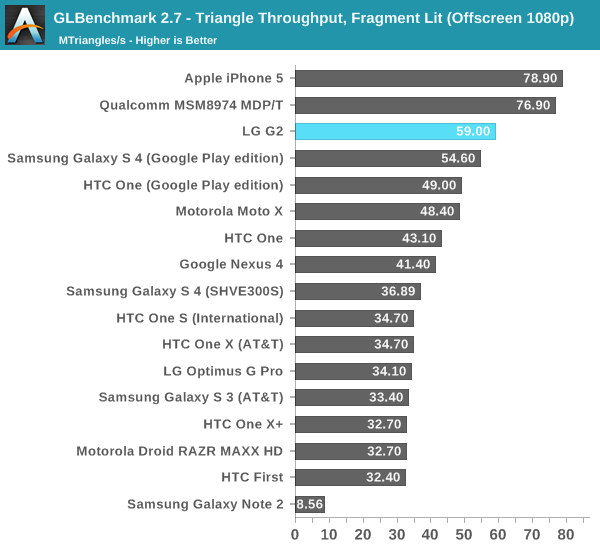
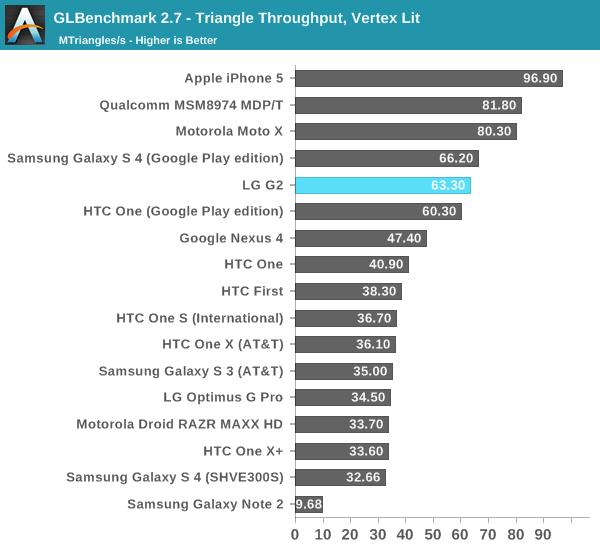
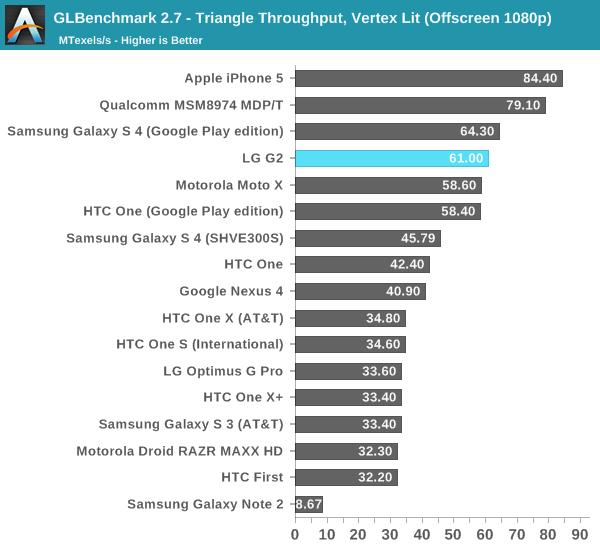
The low level tests put the G2 closer in performance to some of the Snapdragon 600 based devices than the MDP/T, again early software at work here. The T-Rex HD performance looks pretty good, putting the G2 between the S600 devices and S800 MDP/T.
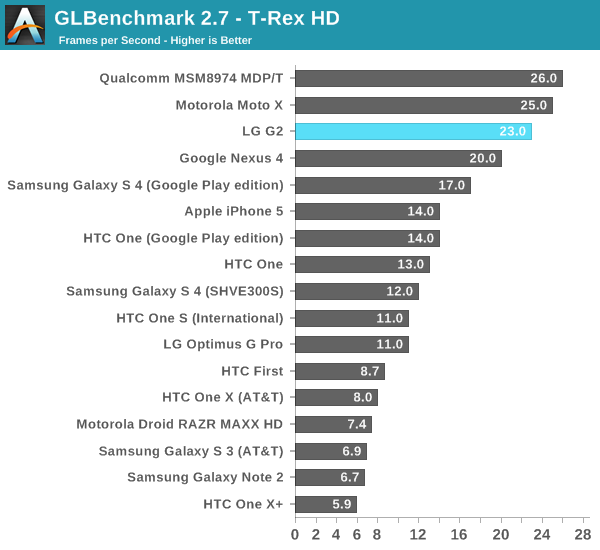
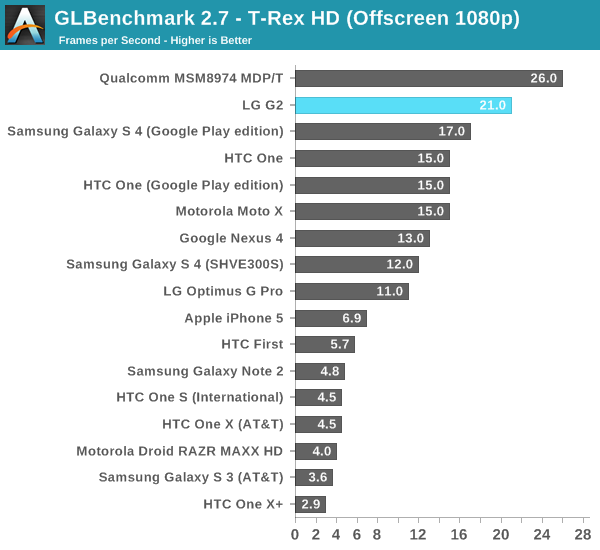
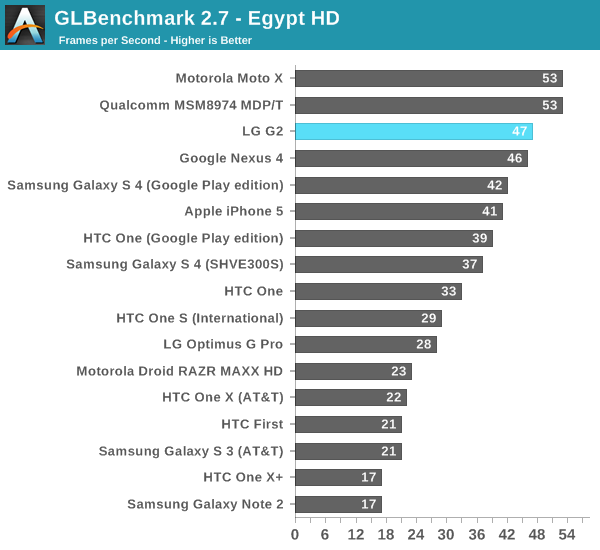
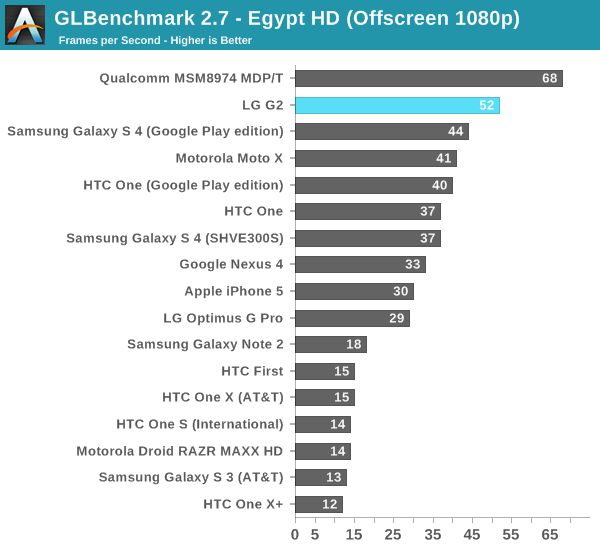
Basemark X
Basemark X is a new addition to our mobile GPU benchmark suite. There are no low level tests here, just some game simulation tests run at both onscreen (device resolution) and offscreen (1080p, no vsync) settings. The scene complexity is far closer to GLBenchmark 2.7 than the new 3DMark Ice Storm benchmark, so frame rates are pretty low:

Basemark X performance tracks with what we saw in the GFXBench T-Rex HD test. Performance is clearly higher than on any other device, but not quite up to MDP/T levels. I wonder how much closer the final device will get.
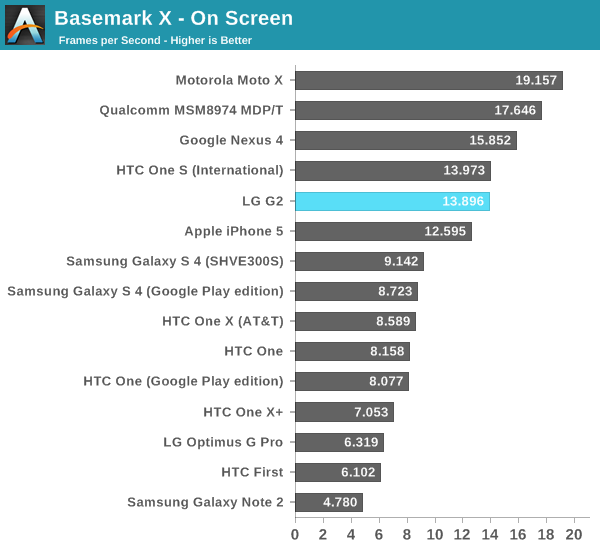
Epic Citadel
Epic's Citadel benchmark gives us a good indication of lighter workload, v-sync limited performance at native resolution. At 1080p, the Snapdragon 800 MDP/T offers over 50% better performance than the Snapdragon 600 based platforms. Granted we're comparing to smartphones here so there's some thermal advantage playing to the 800's favor.
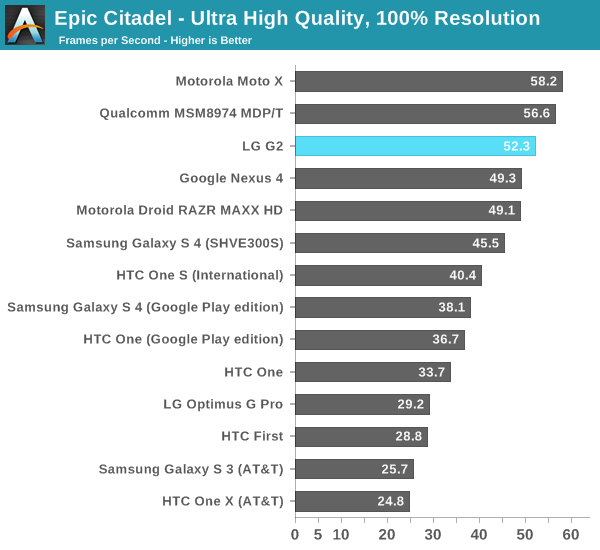










120 Comments
View All Comments
Paulman - Saturday, September 7, 2013 - link
"<b>WOW...</b> wow.... wow, wow..." - That's literally what came out of my mouth when I first saw those battery life graphs. Amazing, LG. GG WPPaulman - Saturday, September 7, 2013 - link
"Gone are the days of 1.4V to hit near-2GHz frequencies it seems, instead 8974 will hit 2.3 GHz at around 1V." - That elicited another 'Wow' from me.andykins - Saturday, September 7, 2013 - link
That is an insane difference. But is there some downside too? Seems a bit good to be true.Froyorkshire - Saturday, September 7, 2013 - link
Heat, most likely. The LG G2 seems to have it taken care of but if the Nexus 4 was any indication, the Nexus 5 needs to have a better-engineered body to handle the S800's potential heat.tuxRoller - Saturday, September 7, 2013 - link
Why would you have more heat when pushing less V and A? Yes, it is clocked higher and has a more powerful gpu so its tdp (or whatever) will be higher than s600 soc, but at the same clocks as the pre-800s it should use less power.This shouldn't be a surprise since this is, apparently, the first time snapdragons have used 28nm hpm, and with new processes come inherent advantages (also problems, but heat shouldn't be one of them unless you are running it at full-tilt).
theduckofdeath - Sunday, September 8, 2013 - link
They reduce the voltage to reduce the wattage, which is what heat is generated from.gwydionjhr - Saturday, September 7, 2013 - link
The side by side comparison video is very interesting. I've only have a light understanding of what I'm seeing, and if you get a chance, I'd really love to get your impressions on how each of these OIS/EIS systems perform. The one question that came to me as my eyes darted back and forth tying to compare the two videos, was that the 1020 OIS seemed to work pretty well, right up to the moment of impact on your footfall. I'm I seeing that right? Is this a result of the weight of the larger sensor in the 1020 maxing out the capabilities of the OIS when those large acceleration forces hit it?Brian Klug - Saturday, September 7, 2013 - link
Accommodation angle is the big game, and they're all also tuned differently too it seems. I'm not walking very aggressively or stomping around either, but trying to walk normally. I wanted to include the Lumia 920 as well but didn't bring it, the 925 seems to be pretty similar to what I remember the 920 being like though.-Brian
UpSpin - Saturday, September 7, 2013 - link
It's funny that in my opinion the 1020 (and so also the 808) does one of the worst jobs in OIS, the 925 the best followed by the HTC One and Moto X. Between them is the rest. LG2 on par with the 1020, in some scenes worse, in some better.In the 1020 vs. 925 comparison, at the beginning, Brian walks along a footway, the 1020 video has a very obvious and penetrant periodic shaking/reflex which does not exist in the 925 or HTC One video.
At the very beginning of the Moto X comparison we see a handrail with a building behinde it, the Moto X video is sharp and steady, the 1020 video wobbles in the z-direction
The colors in the 1020 are the most vivid ones, but in my opinion also the most over saturated and artifical ones. It does a good job in capturing the blue of the sky, but therefore darker details aren't visible on the 1020 videos. (handrail at the end of the test videos)
It's obvious that using a larger sensor a OIS is harder to implement, but I find it odd that Nokia hasn't made any use of the 41MP in video recording mode by additionally implementing an EIS.
But I found it surprising how good or even better the competition is (or how bad the 1020 in videos is), using a cheaper and less intrusive sensor. (in photos the 1020 will probably (and hopefully) remain unbeaten)
Krysto - Sunday, September 8, 2013 - link
It seemed to me the LG one beat the 1020 OIS slightly. The 920 one was the best though, as Brian said. But 920 had far from accurate colors.